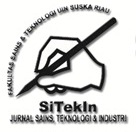Bacteria Classification using Image Processing and Residual Neural Network (ResNet)
Abstract
Full Text:
PDFReferences
A. Wibisono, J. Rachmad, and E. Anderson, “Deep Learning and Classic Machine Learning Approach for Automatic Bone Age Assessment,” 2019 4th Asia-Pacific Conf. Intell. Robot Syst., pp. 235–240, 2019.
C. Rujichan, “Bacteria Classification using Image Processing and Deep Convolutional Neural Network,” 2019.
I. W. S. E. P, A. Y. Wijaya, and R. Soelaiman, “Klasifikasi Citra Menggunakan Convolutional Neural Network ( Cnn ) pada Caltech 101,” vol. 5, no. 1, 2016.
A. Khan, A. Sohail, U. Zahoora, and A. S. Qureshi, “A Survey of the Recent Architectures of Deep Convolutional Neural Networks 1 Introduction,” pp. 1–70.
D. Joshi, “Approaching Bio Cellular Classification for Malaria Infected Cells Using Machine Learning and then Deep Learning to compare & analyze K-Nearest Neighbours and Deep CNNs,” 2017.
S. B. Griesemer and G. Van Slyke, “Assessment of Sample Pooling for Clinical SARS-CoV-2 Testing,” no. January, 2021.
A. Kour, “A Review on Image Processing,” vol. 4, no. 1, pp. 270–275, 2013.
B. Zieli, A. Plichta, K. Misztal, P. Spurek, M. Brzychczy-włoch, and D. Ocho, “Deep learning approach to bacterial colony classification,” 2017.
B. A. Mohamed and H. M. Afify, “Automated classification of Bacterial Images extracted from Digital Microscope via Bag of Words Model,” no. 1, pp. 1–4.
I. Transactions and O. N. Systems, “Efficient and Rapid Machine Learning Algorithms for Big Data and Dynamic Varying Systems,” pp. 1–2, 2017.
A. Buslaev, V. I. Iglovikov, E. Khvedchenya, A. Parinov, M. Druzhinin, and A. A. Kalinin, “Albumentations: Fast and flexible image augmentations,” Inf., vol. 11, no. 2, 2020, doi: 10.3390/info11020125.
S. R. G. B. Grayscale, “Perbaikan Hasil Segmentasi Hsv Pada Citra Digital Menggunakan Metode Segmentasi Rgb Grayscale,” Edu Komputika J., vol. 6, no. 1, pp. 32–37, 2019, doi: 10.15294/edukomputika.v6i1.23025.
F. Ramzan et al., “A Deep Learning Approach for Automated Diagnosis and Multi-Class Classification of Alzheimer’s Disease Stages Using Resting-State fMRI and Residual Neural Networks,” J. Med. Syst., vol. 44, no. 2, 2020, doi: 10.1007/s10916-019-1475-2.
S. B. Kotsiantis, I. D. Zaharakis, and P. E. Pintelas, “Machine learning: A review of classification and combining techniques,” Artif. Intell. Rev., vol. 26, no. 3, pp. 159–190, 2006, doi: 10.1007/s10462-007-9052-3.
J. Feys, “Nonparametric Tests for the Interaction in Two-way Factorial Designs Using R,” vol. 8, no. 2008, pp. 367–378, 2016.
A. Calle-Saldarriaga, H. Laniado, and F. Zuluaga, “Homogeneity Test for Functional Data based on Data-Depth Plots,” pp. 1–25, 2020.
Ö. Karadaǧ and S. Aktaş, “Optimal sample size determination for the ANOVA designs,” Int. J. Appl. Math. Stat., vol. 25, no. 1, pp. 127–134, 2012.
DOI: http://dx.doi.org/10.24014/sitekin.v20i1.16788
Refbacks
- There are currently no refbacks.
Copyright (c) 2022 Dybio Dompu Hot Asih, Adnan Purwanto, Dwiza Riana, Sri Hadianti
 | Editorial Address: FAKULTAS SAINS DAN TEKNOLOGI UIN SULTAN SYARIF KASIM RIAU Kampus Raja Ali Haji Gedung Fakultas Sains & Teknologi UIN Suska Riau Jl.H.R.Soebrantas No.155 KM 18 Simpang Baru Panam, Pekanbaru 28293 © 2023 SITEKIN, ISSN 2407-0939 |
SITEKIN Journal Indexing:
Google Scholar | Garuda | Moraref | IndexCopernicus | SINTA

SITEKIN by http://ejournal.uin-suska.ac.id/index.php

.png)





